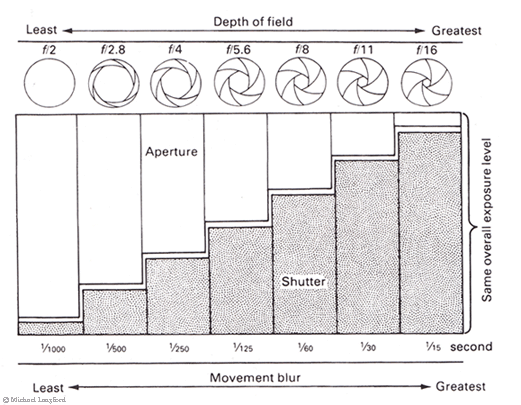DOF assignment
Today we are going to take 12 pictures... manually adjusting the aperture to control depth of field.
- Find an interesting scene with a subject to focus on (tree, flower, person, etc).
- Take that picture with the minimum aperture (write down F-stop and shutter speed)
- Take that exact same picture with the maximum aperture (write down F-stop and shutter speed)
- repeat with a second scene.
- Images should be interesting.
- Shutter should never say "hi" or "lo"
- Do not re-focus between pics. stay focused on the same object.

BRACKETING:
We are going to be adjusting the aperture & shutter (setting the ISO just once to 400) in manual mode today.

We are going to be adjusting the aperture & shutter (setting the ISO just once to 400) in manual mode today.

A series of images demonstrating a focus bracket. The image on the left shows
a single shot taken at f/10 with the features of the fly closest to the camera.
The center image shows the features farthest from the camera.
The image on the right shows focus stacking: a sequence of six incrementally
focused images of the fly assembled to make a composite image using CombineZM.
a single shot taken at f/10 with the features of the fly closest to the camera.
The center image shows the features farthest from the camera.
The image on the right shows focus stacking: a sequence of six incrementally
focused images of the fly assembled to make a composite image using CombineZM.
Depth of field refers to the range of distance that appears acceptably sharp. It varies depending on camera type, aperture and focusing distance, although print size and viewing distance can also influence our perception of depth of field. This tutorial is designed to give a better intuitive and technical understanding for photography, and provides a depth of field calculator to show how it varies with your camera settings.
 |
 |
CIRCLE OF CONFUSION



To have success with this you will need to find a subject that has some
depth. If you take pics of a wall or something that "ends" in your
scene it will be hard to see the DOF. Find a scene where you have a
subject or focal point and then some depth of the scene behind and or in
front of that.
F-stops are the hole in the lens that lets the light in. The
number is just the bottom (ok, the denominator) of a fraction.
- When the lens is set to f2, the hole in the lens is 1/2 as big as the lens is long.
- When the lens is set to f8, the hole in the lens is 1/8th as big as the lens is long.
- Which hole is bigger, 1/2 or 1/8?
- Which hose would let more water through, one that's a half inch in diameter or one that's one-eighth in diameter? (See, there's the first plumbing parallel.)
- Which f-stop lets in more light, f2 or f8?
- When the shutter speed is set to 125, light comes in for 1/125th of a second.
- When the shutter speed is set to 8, light comes in for 1/8th of a second.
- Which is longer, 1/125th or 1/8th?
- If you leave the water turned on for 1/8th of an hour (7.5 minutes), does more water flow than if you leave it turned on for 1/125th of an hour (less than 30 seconds)? (Another plumbing parallel.)
- Which shutter speed lets in more light, 1/8th or 1/125th?
- If you aim a garden hose at your girlfriend and she is running, how much of her gets wet if you only open the nozzle for 1/1000th of a second?
- How much gets wet if you open the nozzle for 1/4 of a second?
- How much will you like it when she hits you with the bucket because you turned the hose on her?
- Here's the plumbing parallel - moving subjects move farther the longer the shutter is open (the longer the hose is turned on.) The more a subject moves during the exposure time (the length of time the shutter is open), the more the image of the subject moves across the film. The more the image moves across the film, the more blurred the image becomes. Short exposure times "freeze" action.
- Which shutter speed freezes action better, 1/8th or 1/500th?
- If the light is bright, it's like strong water pressure.
- It takes less time for just enough light to get to the film.
- High shutter speeds are more suitable for bright light.
- Longer shutter speeds are suitable for dim light, just as you'd leave the faucet turned on longer to fill up a glass if the water pressure is low.
- Let's think of the film speed rating (ISO or ASA or DIN) as a standardized measuring cup.
- Fast films are like small measures. Let's call ISO 800 1 pint.
- We'll call ISO 100 8 pints (that's a gallon.)
- Which takes longer to fill up, a gallon or a pint?
- Which takes longer to properly expose, ISO 100 film or ISO 800?
- Plumbing and photography: Slow films (large containers) require bigger f-stops (larger diameter hoses) and/or longer exposure times (leaving the hose turned on longer) for proper exposure.
-







No comments:
Post a Comment